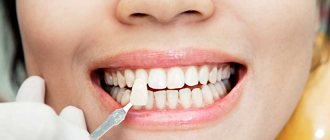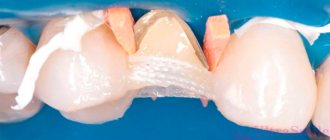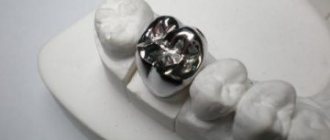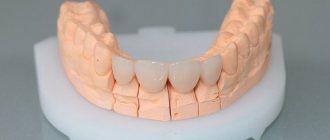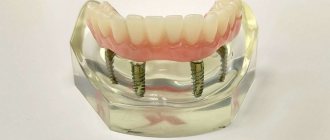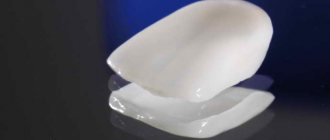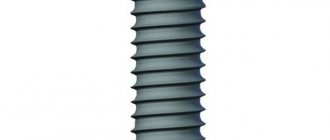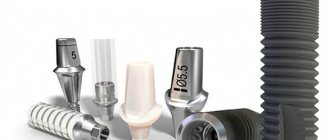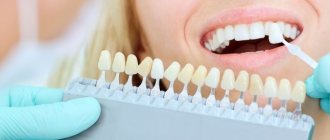What is a bridge?
The fixed structure includes artificial teeth and fastening elements in the form of inlays or clasps. This model of orthopedic system can consist of from one to 4 or even 5 crowns. The product is fixed on supporting teeth or implants and includes one or more artificial crowns, which are attached exclusively to supports, but not to the gum as removable structures.
Photo of a dental bridge
The intermediate structural element can be connected to the oral mucosa in different ways:
- flushing connection: assumes the presence of free space between the bridge and the mucosa, which greatly facilitates the maintenance of hygiene,
- tangent: part of the prosthesis is in contact with the gum, which ensures its better fastening and increased aesthetics. Often used to replace front teeth when appearance is very important,
- saddle-shaped: the product is completely connected to the mucosa. The strength of the product’s fixation will depend on how tightly the structure adheres to the soft tissues. This option is not distinguished by high aesthetics and functionality, but in some cases there is no choice.
Types of bridges for tooth replacement
There are several classifications of bridges. Let's consider what types of structures there are depending on the material:
- metal: today they are rarely used due to their rather low aesthetic values. In addition, such a prosthesis is quite heavy and massive, and therefore can cause some discomfort. Another serious drawback is the high risk of developing an allergy to metal. On the other hand, this is perhaps the most durable, reliable and one of the most budget-friendly prosthetic options,
- metal-ceramic: they are not inferior in strength to their metal counterparts, but they have a more attractive appearance. Ceramic veneer perfectly adapts to the natural shade of tooth enamel. However, the metal frame that runs through the entire structure can be visible through the ceramics, which disrupts aesthetics, especially when it comes to restoring anterior teeth,
“A couple of years ago I had a metal-ceramic bridge installed on the top row. I thought for a long time whether to install it, but in the end I decided. The doctor did everything in literally a week. But before fixing the prosthesis, they ground my supporting teeth so much that they began to look like toothpicks! While the permanent structure was being prepared, I was given plastic crowns. Many people here ask how to get used to the bridge, and I understand you perfectly. I myself experienced discomfort for quite a long time; my teeth felt like they were getting tired. There is only one way out - just wait. It’s also not very convenient that food gets stuck under the denture and it takes a long time to clean it. Otherwise, everything is fine."
Evgeniya, 45 years old, fragment of a message on a thematic forum
- ceramic: the system lacks a rigid metal frame, due to which it becomes less durable than products made from metal-ceramics. Therefore, pure ceramics are not suitable for dental bridges at all.
- plastic: the most financially accessible option, which is characterized by the absence of the risk of developing allergies and excellent aesthetic characteristics. However, the design is not durable, so plastic prostheses are usually used as temporary solutions,
- metal-plastic: more durable and reliable than plastic models, but less durable than metal-ceramic or all-ceramic prostheses. How long does such a bridge last? The average service life of a plastic product with a metal frame is 2 years, while the maximum operational period does not exceed 5 years. In addition, the material tends to change color under the influence of coloring food pigments and saliva. As a result, after some time, the plastic will begin to stand out noticeably against the background of your own teeth1.
Good to know! Today, to create such structures, zirconium dioxide is increasingly used, the color of which ideally matches the shade of tooth enamel. In addition, the material is incredibly durable, which means it can be used to create a very long-lasting bridge that will last for decades.
According to the manufacturing method, bridges are divided into stamped, solid and adhesive. The first ones are created from crowns soldered together. Another name for this model is solder bridge. According to world experts in the field of prosthetics, this method of creating prosthetics is becoming a thing of the past, because it has been replaced by a more reliable casting method. Stamped products are not particularly durable, and the presence of dissimilar metals in the design increases the risk of developing allergies.
An adhesive bridge is indicated to restore the integrity of one tooth. It consists of one crown and fasteners. These can be inlays that are fixed on two adjacent supports, but most often they are “wings,” blades, or plates that are located behind two teeth. In this case, only minor processing of the supporting teeth is required. But this option is not very reliable - it will not withstand heavy loads.
It should be noted that the decision about which option is better depends on the individual clinical picture.
When bridge installation is contraindicated
The structure can be installed in place of one chewing tooth or to restore the integrity of up to 2-3 teeth in a row, provided that there are supporting elements on the sides of the defect that are in good condition. Whether it is possible to install a dental bridge is decided by the attending physician, based on the overall clinical picture.
This method of prosthetics is also characterized by a list of contraindications, which include the following phenomena:
- Bruxism is an uncontrolled clenching of the jaws during sleep, which leads to the gradual erosion of the enamel,
- malocclusions requiring orthodontic treatment,
- advanced form of periodontitis or periodontal disease,
- pathology of bone tissue,
- inflammation in the acute phase,
- low level of hygiene,
- absence of teeth or their poor condition - supporting elements.
Contraindications and indications for the installation of dental bridges
Indications for use
The main indications for installing a prosthetic bridge are:
- the need to replace lost teeth;
- the presence of aesthetic dental defects that cannot be eliminated by other means;
- anomalies and defects formed as a result of injuries or the development of dental diseases.
Contraindications for use
At the same time, bridge prosthetics also has contraindications. These include:
- periodontal disease and periodontitis, occurring in a complicated form;
- bruxism;
- pathological abrasion of dental tissues;
- malocclusion.
It should be noted that the listed contraindications to the installation of bridges are relative, that is, if necessary, many of them can be eliminated during specialized treatment.
The process of creating and installing a structure
- preparatory stage: first, the patient undergoes a complete sanitation of the oral cavity, which includes treatment of caries and removal of dental plaque. In some cases, it may be necessary to remove the pulp from the supporting elements and fill the canals.
- processing of supporting elements: a specialist grinds the teeth, giving them a slightly cone-shaped shape for strong fixation of the prosthesis. If the crowns of the supporting elements are damaged, it may be necessary to strengthen the roots using stump inlays,
- taking impressions: the doctor takes impressions from both jaws to create the most comfortable design,
- making a denture: answering the question of how dentures are made, it should be noted that this is done by professional technicians in a separate dental laboratory,
- The bridge is placed in the oral cavity and attached to the supporting teeth using special dental glue.
Nadent – Natalia Khvorostinova’s Universal Dentistry in Moscow
Bridges from RUB 9,000. All types of dental bridges. Compare prices and choose a dentist.
general information
Dental bridges are permanent dental prostheses consisting of one or more artificial dental crowns that replace lost teeth and are attached to adjacent natural teeth using fixing elements (crowns, inlays, etc.).
A dental bridge (bridge) effectively restores the chewing functions of the teeth without impairing taste and temperature sensitivity in the oral cavity.
In addition, modern bridges are almost completely identical in size, shape and color to natural teeth, which also eliminates aesthetic defects in the dentition.
An important advantage of bridges is the fairly rapid psychological and physical adaptation to them after installation.
Types of dental bridges
There are several types of dental bridges, which, as a rule, differ from each other in the way they are attached to the supporting teeth.
The most common bridge is a design in which an artificial tooth (or several artificial teeth) is rigidly combined into a single unit with two hollow crowns that fit over natural supporting teeth. In this case, the supporting teeth are pre-ground for crowns, which are attached to them with special dental cement.
Sometimes an artificial tooth is attached to the back surface of adjacent natural teeth using special metal plates. This design is called the “Maryland Bridge” (or “Maryland Bridge”).
Dental bridges do not always require grinding of the supporting teeth.
Recently, bridges with locking fastenings have been gaining popularity, which do not require the installation of crowns on the supporting teeth. No less popular is an adhesive bridge prosthesis, which is attached to the supporting teeth using special adhesives (adhesives).
In the absence of one or even two supporting teeth, a bridge can be installed on implants, which are implanted into the jaw in place of the lost teeth and serve as a kind of support for artificial crowns and bridges. This method is especially suitable if too many lost teeth (more than two) need to be replaced.
The choice of a bridge depends on many factors, the main ones being the characteristics of the bite and the general condition of the teeth. The financial issue may also be important in choosing the type of prosthesis.
Any type of bridge has its pros and cons. Only a qualified orthopedic dentist can finally decide which bridge is right for you.
Indications and contraindications for bridge prosthetics
Indications
- Defects and anomalies of teeth caused by injuries and various dental diseases
- Aesthetic dental defects that cannot be eliminated by other methods
- Dental defects
Contraindications
- Bruxism
- Various malocclusions
- Complex periodontitis
- Pathological abrasion of teeth
However, some contraindications are relative and can be eliminated as a result of treatment.
Manufacturing and installation of bridges
Before proceeding with bridge prosthetics, a complete sanitation of the oral cavity is carried out (dental treatment, professional cleaning, filling of supporting teeth, etc.).
Then, in the case of classic bridge prosthetics, the future supporting teeth are prepared (turned) so that the crowns placed on them can be properly fixed and look natural.
Some bridges (for example, adhesive bridges) do not require grinding of the abutment teeth. In this case, small notches are made in the supporting teeth, into which future locks for the bridge are attached using special glue.
After preparing the supporting teeth, the dentist takes an impression of the teeth, with the help of which bridges are manufactured in a dental laboratory within 2-3 weeks.
During this time, the patient can be fitted with a temporary prosthesis that protects the prepared teeth, partially eliminates the aesthetic defect and allows one to get used to the future new form of the dentition.
Crowns on bridges can be made of a variety of materials: metal, plastic, porcelain, metal-ceramics, etc. Recently, metal-ceramic bridges have become increasingly popular in the manufacture of bridges.
For the manufacture of bridges, both stamped and solid metal crowns can be used.
After the permanent bridge is made, it is tried on, fitted and fitted on the supporting teeth.
Particularly important in this case is the normal closure of the teeth of the bridge with the teeth of the opposite dentition.
If necessary, the prosthesis is corrected (either by the orthopedist himself or by a dental technician).
Fitting and final installation of the prosthesis may require 1-2 more intermediate visits to the dentist. Only when the doctor is finally convinced that the bridge can be installed will it be secured to the supporting teeth using dental cement or adhesive materials.
After installation
After installing a dental bridge, it will take some time to get used to it. In case of prolonged discomfort, you should visit a doctor; additional adjustments may be required.
In the future, if you follow certain recommendations for the care of dentures, a dental bridge can serve properly for many years, fully performing the functions of teeth.
In rare cases, if there is a noticeable change in the color of the prosthesis, gum disease or supporting teeth, it may be necessary to reinstall the bridge. Such an operation can only be performed by an orthopedic dentist in a dental clinic.
Pros and cons of such prostheses
Bridges have many undeniable advantages, among which the following characteristics are worth highlighting:
- natural appearance of models made of metal ceramics and zirconium dioxide,
- the possibility of restoring chewing and speech functions,
- quick addiction
- relatively low cost (depending on the material).
As for the disadvantages, you should pay attention to the need to grind the supporting teeth on which the device is fixed. In addition, the use of removable orthopedic structures inevitably leads to bone tissue atrophy. Over time, the prosthesis sags, and therefore there is a need to reline or replace it. The optimal solution to the problem of missing teeth is implantation. This method allows you to stop the process of bone loss and completely restore the functionality of the dental system.
Bone atrophy under the dental bridge
Factors influencing the service life of bridges are:
- bridge length;
- quality of supporting teeth and their quantity;
- the presence or absence of periodontal disease;
- uniformity of regular load on the bridge when chewing food.
After bridge prosthetics, it is recommended to pay special attention to assessing the condition of the supporting teeth, gum tissue, interdental gingival papillae and periodontium. Timely identification of problems that have arisen and their elimination helps to preserve the supporting teeth and, if necessary, re-install a dental bridge.
Features of care
How to brush your teeth and take care of your mouth after having a bridge installed? Experts recommend using a toothbrush with soft bristles. During the procedure, you need to walk over each artificial crown, from the gum to the incisal edge. The presence of a rinsing space in the design greatly facilitates daily oral care. How long a dental bridge will last directly depends on the quality of hygiene. It is also necessary to use an irrigator - it will allow you to thoroughly rinse the gap between the bridge and the gum.
Price issue
How much will it cost to install the bridge? The answer to this question depends on many important factors. The final cost includes the price of the structure itself, as well as its fitting and installation. As for the cost, it all depends on the material and the number of crowns.
Thus, the most inexpensive option is a plastic solution, while the most expensive model is a ceramic prosthesis with a zirconium dioxide frame. Also, the pricing policy of the dental clinic will have a direct impact on the total cost of treatment. The average price for installing a budget plastic structure ranges from 3-5 thousand rubles. A product made of metal ceramics or zirconium (including those fixed to implants) will cost from 20 thousand rubles. You will also have to pay separately for the installation of implants.
Ceramic dentures
Ceramic bridges can be classified as cast, as they are produced by casting ceramic mass into molds with further milling (turning). Zirconium dioxide prostheses are considered one of the most modern - they are maximally biocompatible and have excellent aesthetic properties. These advantages are overshadowed only by the high requirements for their manufacturing technology, but this problem is solved through the active use of computer technology. The color of the material is also selected on the computer.
The high accuracy of fitting of permanent ceramic bridges, including those made of zirconium dioxide, is due to the use of CAD/CAM technology - specialized computer software with a programmable manufacturing process. This technology is actively used in our clinic and has already proven itself to be very positive.
The advantage of ceramic bridges is that they can be used to replace defects that cannot be replaced by other prostheses. For example, 4 missing incisors or 2 small molars can be replaced with ceramic dentures. A relative disadvantage is their slightly lower strength compared to metal-ceramics.
This is interesting! Ceramic dentures are very resistant to all types of loads - static and dynamic, but they can crack from a strong point blow, so you should not click your teeth while trying to crack a nut or open a beer bottle.
Combined dentures
This group includes metal-plastic (metal with plastic lining) and metal-ceramic structures. For many years, the combination of plastic as a facing material and a metal frame has made it possible to carry out effective, visually beautiful prosthetics, especially for anterior teeth. However, with the advent of ceramics, the popularity of metal-plastic structures for dental prosthetics is waning.
The basis for a metal-ceramic bridge is a metal frame onto which ceramics are applied. The frame provides maximum rigidity and strength, and with the help of special processing of the ceramic part, the dentures are given an excellent appearance. At AcademyDent, preference is given to metal-ceramic bridges; the clinic’s specialists have all the necessary skills for their manufacture and installation.
What to do if the bridge falls out
Over time, the dental bridge becomes unusable and may crack or come off. If the prosthesis is broken, in no case should you look for options on how and with what to glue it or at least secure it. So, what to do if the bridge falls off? First, you need to contact your dentist for professional help as soon as possible. Where can I remove my dentures? In such a situation, an orthopedic prosthetist will help you. Since the denture is removed by an experienced specialist, the risk of tooth damage is minimized.
Photo: timely visit to the dentist
Important! What to do if you swallow a dental bridge? In this case, you must immediately seek medical help. An X-ray examination may be necessary, since the sharp corners of the product can injure the stomach.
Many are also faced with the question: what to do if the bridge is wobbly? There can only be one answer here - visit a specialized specialist. This phenomenon may be a consequence of improper installation of the prosthesis or, for example, destruction of the adhesive composition. Weak fixation of the product makes it clear that it is time to change the dental bridge.
Video review from a patient about implantation and prosthetics of chewing teeth on day 4
Alternative
Another competitor to bridge structures is a removable clasp prosthesis. Byugel translated from German means “arch” - due to the special palatal arch in the design of the prosthesis, the load is distributed on all remaining elements of the jaw arch.
A dosed load prevents the thinning of the bone tissue in the jaw, which has a positive effect on the preservation of the tooth.
Like composite bridge systems, clasp structures are fixed in different ways:
- using clasps (hooks);
- micro-locks (you can also find the name “attachments”);
- telescopic crowns.
Thanks to its secure fixation, wearing a clasp device does not affect diction. The patient quickly gets used to the design, and discomfort when eating is practically eliminated.
The clasp type of construction can be used even in the absence of supporting units - they will be replaced with artificial analogues made of acrylic. Installing a bridge in such a situation would be impossible.
In the video, a specialist will tell you how to correct the situation of missing many teeth in the jaw.
